How hand palm characteristics may reveal various type of cancers!
Author: Martijn van Mensvoort
1a - PALMAR SKIN CONDITIONS & CANCERS:
'Tripe palms' relate to lung cancer & stomach cancer:
Tripe palms (a.k.a. 'acanthosis palmaris') describes a skin condition in which the skin of the palm becomes thick and velvety-white with pronounced folds in the lines of the hand. The skin resembles boiled tripe. It's a sign of cancer (in 95% of cases). If only the palms are involved, it's most likely lung cancer. If tripe palms is accompanied by acanthosis nigricans, the underlying malignancy is most commonly stomach (35%) or lung (11%) cancer.
| What are tripe palms? Tripe palms are characterised by thickened velvety palms that have the appearance of tripe, the stomach lining of beef, pork, or sheep. Approximately 90% of cases of tripe palms are associated with internal malignancy. This skin disease is very rare. It usually occurs before the diagnosis of the cancer, but may arise during any point in the course of the malignancy. In over 40% of patients, tripe palms are the first sign of an undiagnosed cancer, hence all patients should undergo a full diagnostic workup for an associated malignancy, particularly lung cancer, gastrointestinal carcinoma, or a colonic polyps. | 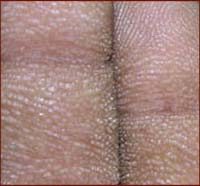 |
| There is no specific treatment for tripe palms. It has been reported that approximately 30% of cases resolve once the underlying cancer is treated. However, tripe palms inconsistently respond to successful therapy and may persist for many years despite remission of the underlying cancer. Sources: Can palm reading pick up cancer? Tripe palms are a.k.a. ‘acanthosis palmaris’ What your skin says about your health 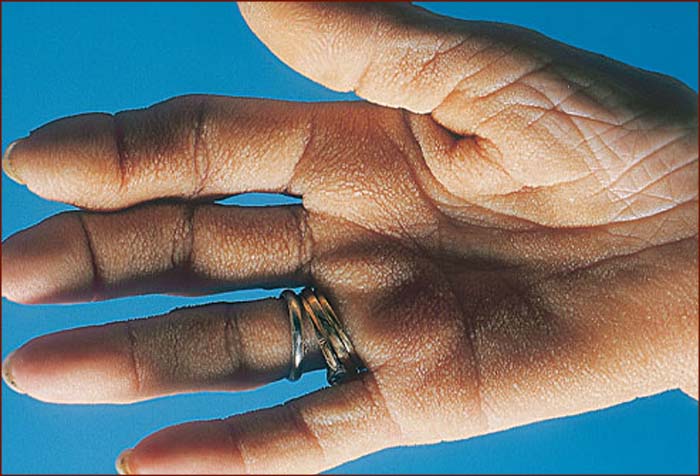 |
| 1b - PALMAR SKIN CONDITIONS & CANCERS: 'Palmar keratosis' is more often seen in various types of cancer: 'Palmar keratosis', concerns a skin condition characterized by an overgrowth of keratin on the skin of the hand (usually papules or pits). This skin condition in the hand is about 4 times more frequently observed in persons with cancerous tumors - compared to healthy individuals (11% to 23%). Multiple studies have indicated that 'palmar keratosis' is often seen in patients with various type of cancers, including: bladder cancer (67% to 87%), lung cancer (71%), breast cancer, renal cancer & colon cancer. 'Palmar keratosis' (sometimes misspelled as: keritosis) is in medical science a.k.a. 'keratosis punctata palmaris et plantaris' [KPPP] which is known as a skin condition found on both the hands & feet. NOTICE: In white people the papules and pits are usually NOT found in the palmar creases. NOTICE: 'Keratosis' is a very common (pre-cancerous growth) skin condition that can be found on various body parts in far most people. 'Keratosis pilaris' (a.k.a. 'follicular keratosis') is a very common (genetic) skin condition characterized by the appearance of small bumps usually white in color (sometimes refered as 'chicken skin') - very frequently found on body parts including: the backs of the upper arms, thighs, and (especially in women) the buttocks areas. 'Actinic keratosis' (a.k.a. 'solar keratosis' or 'senile keratosis') is the most regular type of 'skin keratosis' that is often seen on body parts of light-skinned persons that have been chronically exposed to the sun, including: the face, skull, back of the neck, tops of the forearms, and (especially in men) even the tops of the ears. |
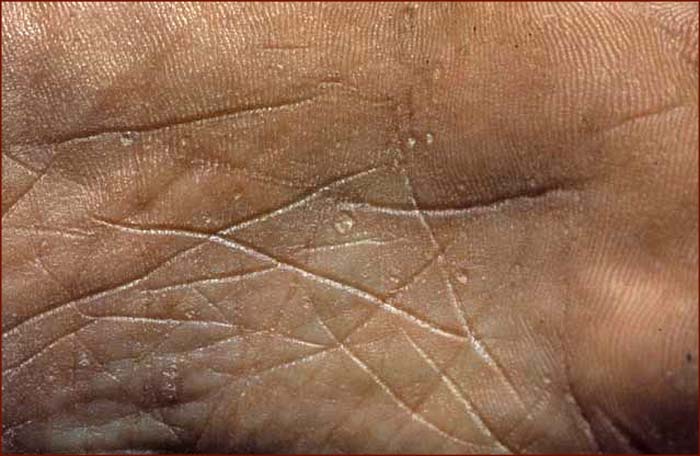 |
| Do not confuse the following 3 skin conditions with 'palmar keratosis'! 1 - First of all, one should NOT confuse 'palmar keratosis' with another very common and typical inner palm skin condition called: 'calluses' (the latter is usually the result of repeated pressure and friction, and can often be observed in the palmar zones below the fingers). 2 - Second, one should NOT confuse 'palmar keratosis' with a less common hand skin condition called: 'keratosis punctata of the palmar creases' (a.k.a. 'Keratosis punctata of the palmar creases' [KPPC]), which concerns the presence of pits in the hand lines - these are much more often seen in the hands of black people (1.9% to 3.1%), especially in males. But these punctata in the creases do not have an association with any type of cancer at all!  Sources: The hand-foot syndrome! Puzzling palmar papules and pits Palmar keratosis in persons with cancerous tumors Palmoplantaris keratosis: thickening of the palms AND the soles |  PHOTO: Palmoplantar keratosis [PPK] is a rare variant of the relatively normal 'palmar keratosis'. 3 - Thirdly, one should NOT confuse 'palmar keratosis' with a condition called 'palmoplantar keratosis' [PPK] - see the picture on the right. 'Palmoplantar keratosis' concerns a congenital, often hereditary, thickening of the horny layer of the skin of the palms and soles, sometimes with painful lesions resulting from the formation of fissures. |
'Palmar fascial thickening' relates to ovarian cancer & various other cancers:
Curling or thickening of the hand palm combined with swelling of the fingers, making the hand look like wood with lumpy areas. It's called PFPAS, a.k.a the 'palmar fasciitis and polyarthritis syndrome'. Combined with a deepening of the palmar lines this hand characteristic is since 1982 known as a signal for ovarian cancer - but it's a very rare condition for since then about 40 cases have been reported. Nevertheless, this palm condition has also been associated with colon cancer, pancreas cancer, lung cancer, cervix cancer and hematolymphatic malignancies.
| What are the 'palmar fascia'? The palmar fascia lie under the skin on the palm of the hand and fingers. These fascia are a thin sheet of connective tissue, and the fascia separate into thin bands of tissue at the fingers. The fascia cover the tendons of the palm of the hand and holds them in place. It also prevents the fingers from bending too far backward when pressure is placed against the front of the fingers. NOTICE: a common problem with the palmar fascia concerns 'Dupuytren's contracture': which is characterised by the forming of nodules and the thickening of tissues and shorten. 'Dupuytren's contracture' usually results in the bending of fingers until the finger cannot be fully straightened. | 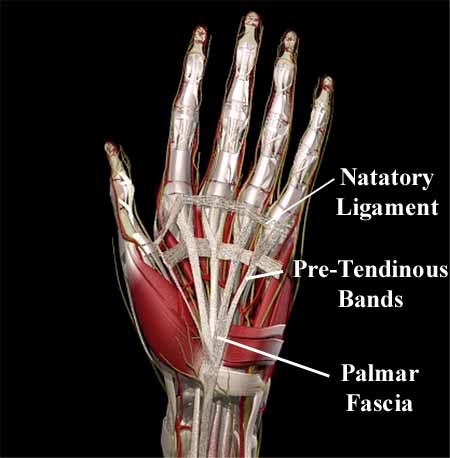 |
| PFPAS is a 'paraneoplastic syndrome' featured by pain of the hands. The basic characteristic of 'paraneoplastic syndromes' is that they are characterised by not being produced by the primary tumor itself, and also it is not caused by compression or treatment of the tumor. Sources: Doctor picked up ovarian cancer through palm reading! Palmar fasciitis and polyarthritis associated with ovarian carcinoma The palmar fasciitis and polyarthritis syndrome: discussion of diagnosis 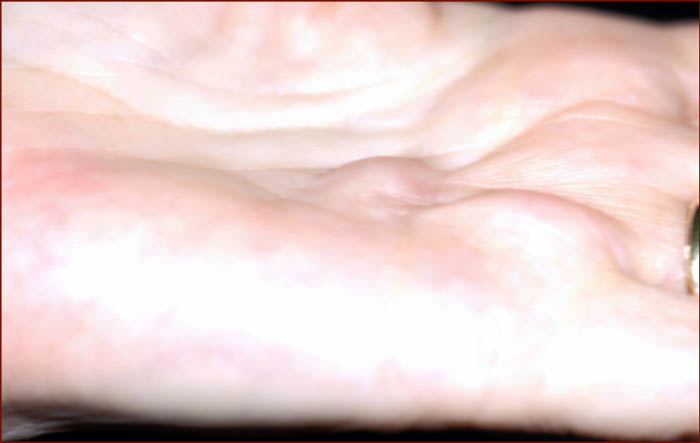 |
No comments:
Post a Comment